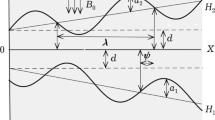Abstract
This paper unambiguously derives, ab initio starting from the Navier–Stokes and Laplace equations, the geometric parameters defining capillary pumps (CPs) with rectangular cross section with constant volumetric flow rate and steady velocity profile. The parametric formulation of the channel shape is derived using Taylor series approximations of the capillary pressure and the hydrodynamic flow resistance with negligible error. First, the design parameters are derived for a CP consisting of a single channel and illustrated with an example. Thereafter, the design parameters for multichannel and for micropillar array CPs are derived. Finally, the design of CPs for multistep constant flow rates derived and those for arbitrarily varying flow rates are discussed.






Similar content being viewed by others
References
Bruus H (2008) Theoretical microfluidics. Oxford University Press, Oxford
Chandra D (2009) Capillary force in high aspect-ratio micropillar arrays. PhD thesis, University of Pennsylvania
Eddowes RMJ (1988) Controlled flow rate capillary suction pump. United Kingdom Patent GB2208324
Gervais L, Hitzbleck M, Delamarche E (2011) Capillary-driven multiparametric microfluidic chips for one-step immunoassays. Biosens Bioelectron 27:64–70
Juncker D et al (2002) Autonomous microfluidic capillary system. Anal Chem 74:6139–6144
Man PF, Mastrangelo CH, Burns MA, Burke DT (1998) Microfabricated capillarity-driven stop valve and sample injector. In: Proceedings of IEEE MEMS’98 conference, Feb 1998, Heidelberg, Germany, pp 45–50
Melin J, Gimenéz G, Roxhed N, van der Wijngaart W, Stemme G (2004) A fast passive and planar liquid sample micromixer. Lab Chip 4(3):214–219
Mirzaei M et al (2010) Microfluidic perfusion system for culturing and imaging yeast cell microarrays and rapidly exchanging media. Lab Chip 10:2449–2457
Safavieh R, Juncker D (2011) Serpentine and leading edge capillary pumps. In: Proceedings of the 15th international conference on miniaturized systems for chemistry and life sciences (microTAS) October 2–6, 2011, Seattle, Washington, USA, pp 245–247
Shah RK, London A (1978) Laminar flow forced convection in ducts: a source book for compact heat exchanger analytical data. Supplement 1, pp 198–199. ISBN:0-12-020051-1
Acknowledgments
This work received partial financial support from the European Commission in the framework of the FP7 project ROUTINE. This manuscript was conceived and written at the border of Lake Särkijärvi in Finnish Lapland during July 2013, and I would like to thank my wife and children for their patience, Mumma for the cookies, and Ukki for the fish.
Author information
Authors and Affiliations
Corresponding author
Appendix
Appendix
This appendix derives an expression for the capillary pressure in a channel with rectangular cross section. We will first derive such expression for a zero-th order Taylor series approximation for w(s) around s = x, and thereafter for first order Taylor series approximation. The latter will allow estimating the maximum error induced by the zero-th order approximation, and hence the interval of s where such approximation is valid. The below is an expansion of the work by Man et al. (1998). We start from
where U S, V l, A sl, A la and γ denote the total surface energy of the channel geometry, the liquid volume in the channel, the total wetted area of the channel, the total liquid–air interfacial surface area and the liquid–gas surface energy, respectively.
For a zero-th order approximation w(s) = w(x), the capillary pressure equals that of a liquid in a rectangular channel with constant cross section, see Fig. 7.
The shape and area A lg of the liquid–gas interface remains constant as the liquid front advances, and hence
Inserting Eqs. 47 and 48 in 46 results in
For a first order approximation w(s) around x, the capillary pressure equals that of a liquid in a tapered channel with a rectangular cross section of which the width w decreases linearly with increasing s, as shown in top view in Fig. 8.
As in the above case, the liquid–gas interface constitutes a complicated 3D surface that cannot be generally described parametrically. If \(w \ll h\), the shape of the interface surface is close to that of a parallel plate slit, i.e. cylindrical. We will here solve the capillary pressure drop for such cylindrical surface shape, as depicted in Fig. 8, and assume that the results can be extended to general liquid surface geometries for w ≤ h.
Defining
and
we can calculate
Substituting 50, 52, 53, and 54 in 46 results in
which can be rewritten as
Rights and permissions
About this article
Cite this article
van der Wijngaart, W. Capillary pumps with constant flow rate. Microfluid Nanofluid 16, 829–837 (2014). https://doi.org/10.1007/s10404-014-1365-3
Received:
Accepted:
Published:
Issue Date:
DOI: https://doi.org/10.1007/s10404-014-1365-3






